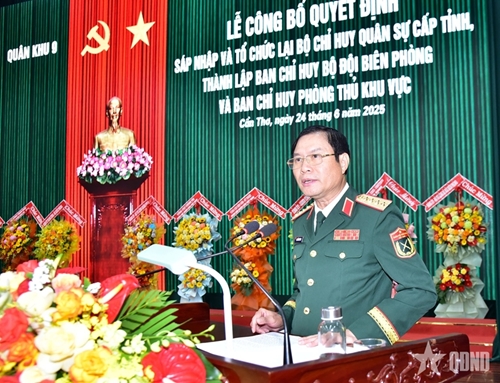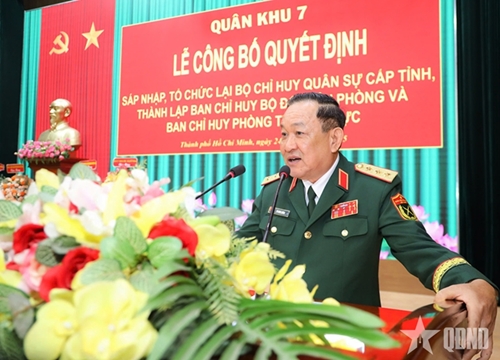Senior Lieutenant General Trinh Van Quyet, Chief of the General Department of Political Affairs; General Nguyen Tan Cuong, Chief of the General Staff and Deputy Minister of National Defense; Sr. Lt. Gen. Vo Minh Luong, Deputy Minister of National Defense, attended ceremonies held by the Hanoi Capital Command, the Military Region 9 Command and the Military Region 7 Command, respectively.
    |
 |
|
Sr. Lt. Gen. Trinh Van Quyet hands over “Determined-to-Win” military flag to one of the five defensive area commands of the Hanoi Capital Command. |
Under the decisions, the Hanoi Capital Command has five defensive area commands, namely Soc Son, Phuc Tho, Hong Ha, Gia Lam and Thanh Oai.
Meanwhile, in Military Region 9, there are five provincial-level military commands, namely Can Tho City, Vinh Long An Giang, Dong Thap and Ca Mau. Each provincial military command has one border guard command and several defensive area commands.
In Military Region 7, together with the Ho Chi Minh City Command, there are Dong Nai, Lam Dong and Tay Ninh provincial Military Commands and each having their own border guard commands and several defensive area commands.
During ceremonies, newly-established units received “Determined-to-Win” military flags.
    |
 |
|
General Nguyen Tan Cuong speaks at the ceremony held by Military Region 9. |
Addressing the event hosted by the Hanoi Capital Command, Gen. Quyet affirmed that the establishment of defensive area commands is a long-term strategic decision, reflecting the creative organizational mindset and scientific, innovative vision of the Party, State, CMC, and Ministry of National Defense. It realizes the goal of building strong, streamlined, effective local armed forces in the context of the comprehensive military restructuring towards modern, practical, and high-combat-readiness operations.
In their speeches, the three defense leaders asked the newly-established units to promptly stabilize their organization and personnel structure, and operate effectively from the very first day. They should also ensure coordination with Party committees and authorities at all levels, and serve as extended arms linking military leadership from the city down to wards and communes. They must quickly develop regulations, maintain regular discipline, formulate operational plans, and organize training and exercises in close coordination with relevant forces to stay ready for any situation. Additionally, they should proactively advise local Party committees and military commands on military posture, defensive posture, combat structures and dual-use infrastructure to meet modern warfare requirements and to serve local defense and socio-economic development.
    |
 |
|
Sr. Lt. Gen. Vo Minh Luong attends the ceremony held by Military Region 7. |
They should also build strong, exemplary, and healthy Party organizations; enhance thought management and political education; build contingents of professional and politically firm troops and personnel; maintain strong internal unity and tighten military-civilian relations; as well as prepare for Party congresses at defensive area commands.
New military, border guard and defensive area commands in Military Regions 1, 3, 4, 5 were also announced during similar ceremonies held the same day.
Translated by Mai Huong